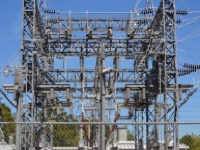|
|
|
|
 |
|
 |
 |
|
Business
Continuity
Services |
When considering which option meets your business continuity strategy requires a careful analysis of capital, operating and utility costs along with a risk assessment and opportunity must be thoroughly reviewed with a side by side study.
Contingency Strategies:
|
Our Energy Advisory group has thorough knowledge of utility issues, methods, technologies, infrastructure; cost structures and possess the experience in both utility economic development and customer service

ELECTRIC SERVICE BUSINESS CONTINUITY OPTIONS
The last few years have significantly challenged managing business continuity issues because of major weather events. On the East Coast Hurricane Sandy and Irene caused damage and high tidal waters that devastated coastal and non-coastal areas. In the Midwest / Ohio Valley severe weather changes, an earth quake in Virginia, tornadoes in Texas and the Great Plains accompanied by severe droughts contributing to forest fires, and early to late season snow storms in many areas have caused significant interruptions to business operations over the past two years alone.
When should I look into back up generation?
Alternative utility feed
Emergency back-up generation
For most commercial operations this is the most feasible alternative for an alternate electric supply during a storm event. An owner needs to consider a sound strategy when researching installation of an emergency backup generator. Should the unit be sized for the entire building? Should the unit be sized to provide power for emergency operations for; life support, emergency and fire safety equipment, service for elevators, critical data systems, and emergency lighting and security? If the strategy is only for emergency supply the process is not that daunting. However, if the strategy is to power the entire building and run as if there was no interruption of the utility electric service, then a more complex system must be considered. These generators are more costly and have additional considerations, costs and risks associated with them. Issues include:
- Purchase and installation costs
- Multiple generators
- Space allocation for generators and associated equipment siting
- Local zoning and permitting issues
- Air quality permits
Cogeneration
Cogeneration, often called “combined heat and power “(CHP) is
defined as the simultaneous
production of energy and useful heat. Locally produced energy
along with the reuse of waste
heat is more efficient then utility produced energy. In theory
this is accurate, but, due to
economies of scale, the utility has cost advantages which make
the use of waste heat
essential. Waste heat is used for both heating and cooling
purposes and can have benefits for
a customer capable of utilizing both.
Cogeneration applications are better suited for new construction
or redevelopment projects
as a result of the design and costs concerns. However,
cogeneration can be retrofitted into an
existing project but will present some installation and design
challenges.
Cogeneration fuel choices are the same for all systems (see
below) and must be considered.
However, most cogeneration facilities use natural gas as their
primary fuel source. Another
issue for consideration is that the generation is typically
sized to meet the thermal load of the
facility and often does not meet the full operational electric
load of the site. Therefore,
electric service from the local utility must be installed to
meet the electric load beyond what is
supplied by the cogeneration plant. Cogeneration facilities also
require maintenance related
downtime and there’s always a chance of un-planned outages due
to equipment failure; both
create a situation requiring utility back-up to the cogeneration
plant.
Cogeneration (with utility backup)
Businesses who select a cogeneration option require backup
electric service from the local
utility and it should be sized to meet all or defined partial
amount of the electric load of the
entire site. Similar to utility duplicate service discussed
above, there are costs for this service
type from the utility. The utility backup service to the
cogeneration plant comes with
additional requirements and costs:
- Excess facility charges
- Reserve capacity charges
- Demand charges and other fees associated with backup service
- Cost and space for utility electric service equipment
- Manual or automatic transfer switching and other safety equipment
Cogeneration (no utility backup “off grid”)
Some recent projects are considering no utility electric service
(off grid) by providing all the
energy needs on site. With the advancement in equipment design,
cost and reliability this
option is gaining traction. However, it is not for every
application. It requires significant capital
cost, redundant design specifications and both a primary and a
secondary fuel option,
technical expertise to operate and significant on-going
maintenance.
The off grid option is only recommended for new projects and is
an unlikely option for existing
facilities. Serious risk assessment associated with equipment
outages, equipment
replacement, service contracts, and redundant generation
capabilities must be considered.
Distributive Generation
In some areas of the country state regulatory agencies, transmission grid operators and local utilities are considering distributive generation options to enhance local transmission and distribution system reliability in an effort to reduce outage durations. As these programs advance, they offer the opportunity to financially support one or more of the cogeneration options listed above. This option requires significant knowledge of utility rate design, utility policies and interconnection requirements of the utility and other regulatory agencies. In essence you are building a utility grade privately owned electric distribution system within the site perimeter and you’re fully responsible for its operation and maintenance.
Fuel Choice Pros and Cons
|
Natural Gas |
Fuel Oil |
|
Advantages
|
Advantages
|
|
Disadvantages
|
Disadvantages
|
In Summary
When considering which option meets your business continuity strategy requires a careful analysis of capital, operating and utility costs along with a risk assessment and opportunity must be thoroughly reviewed with a side by side study. Each site presents its own challenges and opportunities to help mitigate business continuity issues. A detailed review of each facility’s susceptibility to natural and manmade disasters along with the availability of local utility infrastructure options is required to ensure a company meets its’ business continuity strategy in the most cost effective and reliable manner.
Sugarloaf Associates, LLC provides comprehensive energy services and procurement strategies, including utility relocation, energy procurement, utility rate tariff and billing issues, green building requirements associated with economic development incentive awards, renewable energy installations, and electric and gas infrastructure assessments with a specialized capability in mission-critical facilities.
| © Sugarloaf Associates, LLC | PO Box 2967, Key West, FL 33042 | email us, or call 973.908.8232 |
